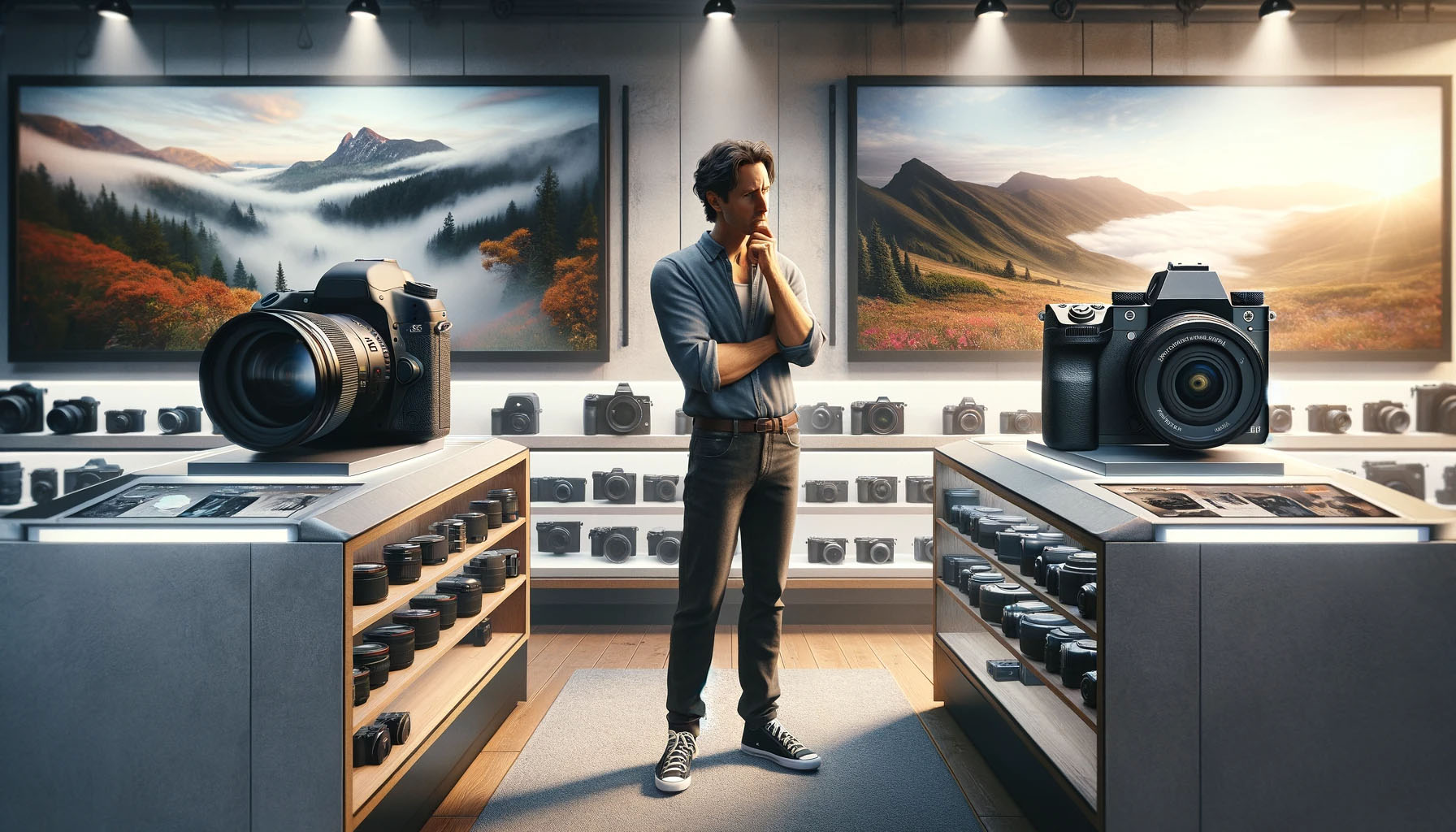
Introduction
When I think about photography, one of the first big decisions that comes to mind is choosing between a DSLR and a mirrorless camera. This choice isn't just about picking a type of camera; it's really about finding what works best for my photography style. Let me explain what makes mirrorless cameras different. Unlike DSLRs, which use mirrors to send light to the viewfinder, mirrorless cameras don't have these mirrors. Instead, the light goes straight to the camera sensor and then to an electronic screen in the viewfinder.
This difference between the two types of viewfinders is a big deal. It changes how I see things through the camera and affects my whole photography experience. In this guide, I want to share with you everything I've learned about these cameras. We'll look at the pros and cons of both optical and electronic viewfinders, and other important things like autofocus, how easy the camera is to handle, and what kind of lenses you can use.
Whether you're just starting out in photography or you've been doing this for a while, it's really helpful to understand these differences. But it's not just about viewfinders. I've realized there's a lot more to think about. So, I'm going to take you through all these details, breaking down the technical stuff into simple terms. This way, you can see the bigger picture and make the best choice for your photography journey. Let's dive into this fascinating world of DSLR and mirrorless cameras and figure out together what suits our photography needs the best.
Optical vs Electronic Viewfinders: A Pivotal Choice
The choice between a DSLR (Digital Single-Lens Reflex) camera and a mirrorless camera often boils down to a pivotal decision - whether to go with an optical viewfinder or an electronic one. This represents one of the most crucial differences between the two camera types and serves as the photographer’s primary viewing portal, shaping both the creative process and end results. As the critical eyepiece that composes and previews the scene, the viewfinder acts as the camera’s window to the world. This makes it one of the most vital components that influences how images are envisioned, executed, and ultimately captured. DSLRs present a real-time optical reflection of the external scene by utilizing complex mirror systems to reflect light directly onto optical glass at the eye. In contrast, mirrorless cameras offer an electronic display powered by the sensor - converting the incoming light to digital imaging algorithms rather than using the physics of light passage alone. This means at the most fundamental level, optical and electronic viewfinders provide vastly different user experiences with their own inherent strengths and constraints. Optical allows an organic, lag-free view with unsurpassed visual accuracy. Electronic enables information-rich previews showing exposure impacts but introduces pixelation concerns. As a photographer’s most intimate feedback mechanism between eye and subject, the viewfinder plays a profound role as the gateway for photographic creativity. So understanding these core optical versus electronic differences is essential for those exploring DSLR and mirrorless systems.
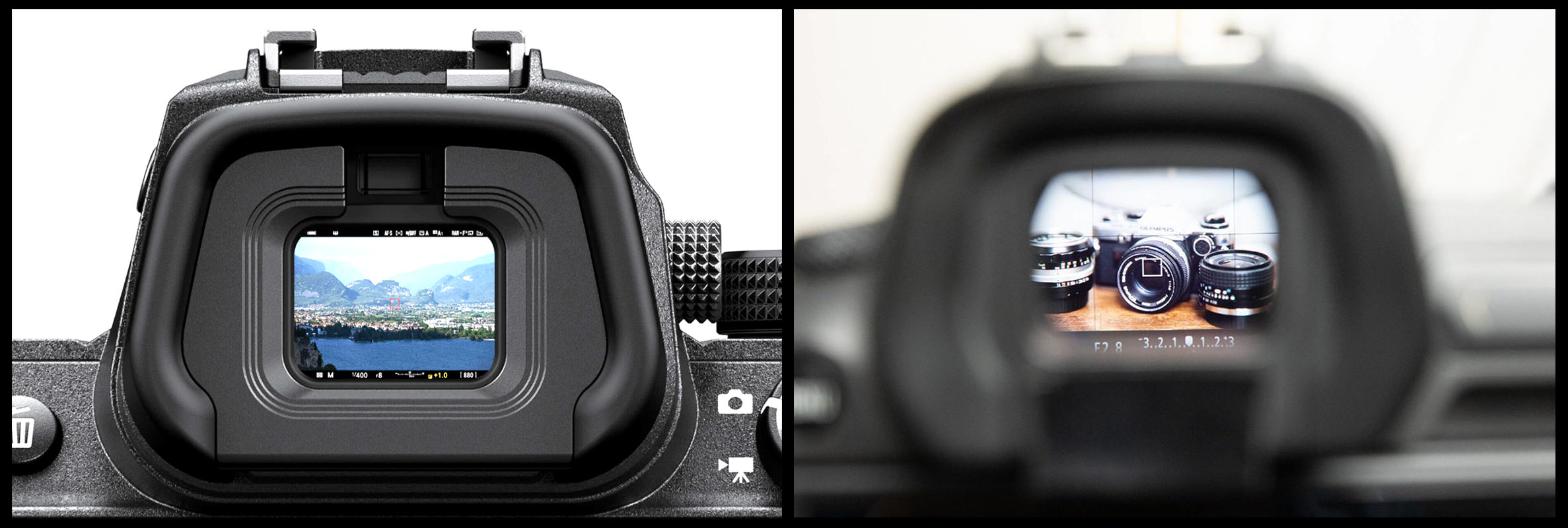
DSLRs and Optical Viewfinders (OVF)
DSLR cameras are equipped with Optical Viewfinders (OVFs) that utilize a Through The Lens (TTL) system, offering photographers a real-time, natural view directly from the lens. This TTL approach means photographers see exactly what the lens captures, enabling accurate composition and framing of shots. The light entering the lens is directed towards the viewfinder, allowing the photographer to see the scene as the camera lens sees it.
At the heart of this system are sophisticated optical components, including prisms, which play a crucial role in the functionality of OVFs. A key element here is the pentaprism, a five-sided reflecting prism. It deviates a beam of light by a constant 90 degrees, ensuring the transmission of an image through a right angle without inverting it. This feature is crucial because it maintains the image's orientation, unlike ordinary prisms or mirrors that would invert the image.
In many DSLR cameras, a variant of the pentaprism, known as the roof pentaprism, is commonly used. The camera lens renders an image that is both vertically and laterally reversed. Although the reflex mirror in the camera re-inverts it vertically, the image remains laterally reversed. The roof pentaprism addresses this by laterally reversing the image back to normal. It replaces one of the reflective faces of a standard pentaprism with a "roof" section, which consists of two additional surfaces angled towards each other at 90 degrees. This design ensures that the image viewed in the viewfinder is correctly oriented.
When the shutter button is clicked, the main mirror moves out of the way, allowing light to travel directly onto the image sensor for the actual photo capture. This process, while providing an intuitive and organic perspective for lining up shots, may lead to slight differences between the optical view and the final digital image. Nevertheless, the OVF, enhanced by the pentaprism and roof pentaprism, offers a clear, accurately oriented approximation of the scene, free from electronic processing distortions. The integration of these advanced optical components underscores the OVF's capability to provide an accurate representation of the scene, making it a preferred choice for many photographers.
The key advantages of this system include:
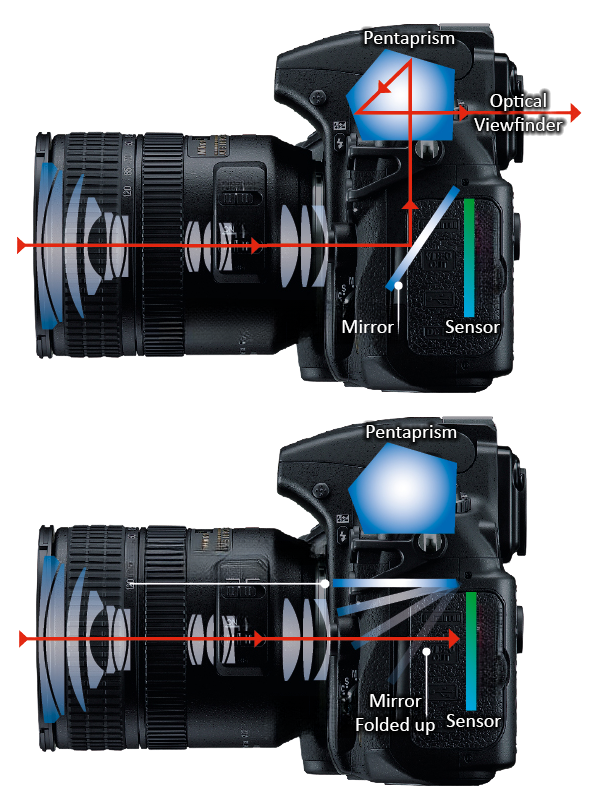
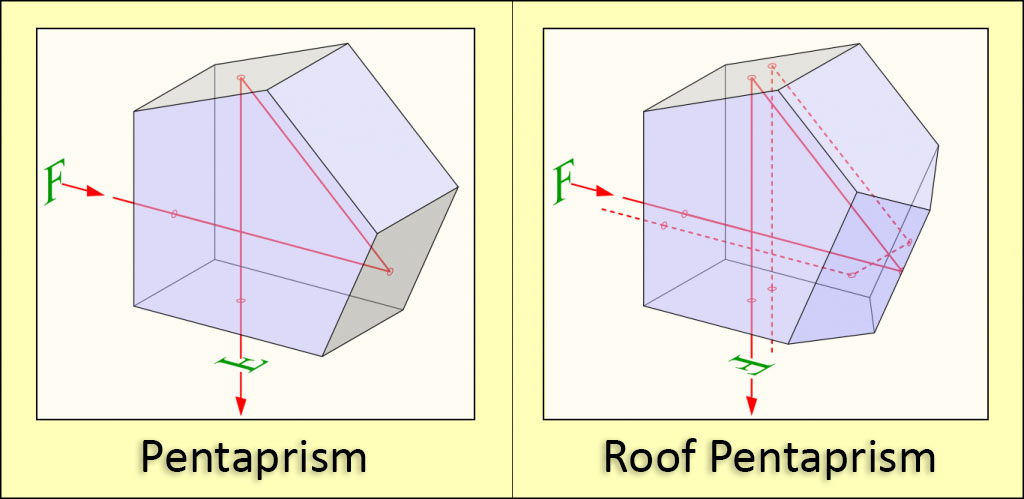
Mirrorless Cameras and Electronic Viewfinders (EVF)
In contrast to DSLR optical systems, mirrorless cameras utilize electronic viewfinders (EVFs). These EVFs digitally display the image being seen by the camera sensor directly to an electronic view panel or micro screen within the viewfinder. This projection thus provides a technology-enhanced perspective of the scene. Unlike reflecting natural light from a mirror, the EVF generates its view using algorithms to translate the sensor data into the viewfinder image preview in real-time. This means EVFs offer a natively digital window, powered by electronic systems, rather than utilizing the physics of light passage alone. The technological nature of electronic viewfinders is a double-edged sword - while enabling advanced features impossible with optics, this electronic core also introduces key constraints around resolution, processing, amplification, and ultimately the ability to match natural visual accuracy. Now with the stage set on the fundamentals of how EVFs operate differently than optical systems, we can segue nicely into their unique advantages and persistent limitations driven by their underlying technology base.

Advantages of Electronic Viewfinders in Mirrorless Cameras
Electronic viewfinders (EVFs) in mirrorless cameras offer a plethora of benefits, making them a preferred choice for both budding photographers and those engaged in creative exploration. Below are some key advantages:
- Real-Time Exposure and Settings Feedback: The EVF provides real-time updates of exposure settings, including shutter speed, aperture, and white balance adjustments, along with depth of field previews. This instant feedback is invaluable, allowing photographers to visualize the impact of their settings on the final image in real time, enhancing the learning curve and creative control during the shoot.
- Advanced Display Features: EVFs come equipped with advanced display functionalities like live histograms and zebra stripes for highlighting overexposed areas. These features deliver crucial information, enabling photographers to make precise, on-the-fly adjustments. This is particularly beneficial in complex lighting conditions or when striving for perfection in focus, such as in macro or portrait photography.
- Automatic Eye Focusing: Leveraging the sensor's full focusing potential, EVFs facilitate advanced focusing features such as automatic eye detection. This is particularly advantageous for portrait, bird, and wildlife photography, ensuring sharp focus on dynamic subjects. The technology also extends to detecting and focusing on other subjects like flowers and vehicles, ensuring consistently sharp images.
- Enhanced Low Light Performance: In low-light conditions, where optical viewfinders struggle, EVFs excel by amplifying the scene. This feature allows for easier composition, focusing, and image capture in dimly lit or nighttime environments, significantly enhancing the camera's usability in diverse lighting situations.
- Previews: EVFs empower photographers with the ability to preview creative effects like black and white, sepia tones, various aspect ratios, picture styles, and special effects in real-time. This direct visual feedback fosters a more intuitive and spontaneous creative process.
- Comprehensive Focus Points Coverage: EVFs typically offer complete frame coverage for focus points, in contrast to optical viewfinders, which are often limited to central coverage. This extensive coverage enhances compositional flexibility and precision.
- Silent Electronic Shutter: The absence of a physical shutter mechanism in EVFs allows for completely silent operation. This feature is particularly beneficial in settings like weddings or other environments where noise minimization is crucial.
- Enhanced In-Body Image Stabilization (IBIS): EVFs facilitate the use of sensor-based image stabilization. Unlike lens-based stabilization systems, EVFs enable the sensor itself to compensate for hand movements, enhancing the effectiveness of image stabilization across various shooting scenarios.
- Manual Focus and Exposure Assistance: EVFs offer specialized features such as focus magnification, focus peaking, and exposure zebras. These tools make manual focusing and exposure adjustments more precise and intuitive, which is a significant advantage in genres like macro photography and landscape photography, where accuracy is paramount.
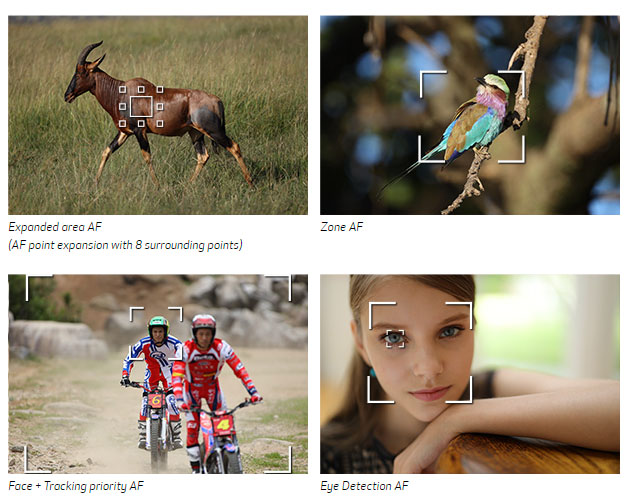
Other Key Considerations in the DSLR vs. Mirrorless Debate
Beyond just viewfinder mechanisms, there are several other important factors to weigh when deciding between DSLR and mirrorless cameras:
- Size and Weight: Mirrorless camera systems offer a more portable, compact and lightweight overall package compared to most DSLR setups, which can be hugely beneficial for travel photography, hiking, and roaming around cities capturing street photography scenes.
- Autofocus Performance: While DSLRs have historically had an edge in terms of speed and accuracy, modern mirrorless cameras have closed the gap dramatically, offering incredibly fast and reliable autofocus even in low light situations or when capturing video.
- Battery Life: Due to their simpler mirror mechanism and optical viewfinders, DSLRs typically win out when it comes to battery life longevity, although the gap is narrowing each product generation as mirrorless cameras become more power efficient.
- Available Lenses and Accessories: DSLR cameras currently benefit from a vast array of available lenses and accessories that have built up over decades. However, the mirrorless lens market is expanding at a rapid pace, with many adapters available for using existing DSLR-mount lenses on mirrorless camera bodies.
- Performance: Mirrorless camera systems often far outshine even high-end DSLRs when it comes to video capabilities, offering higher video resolutions like 4K and 8K, better autofocus, faster frame rates, and more advanced features like logs and high bitrates.
Conclusion
As we stand at the crossroads of photographic evolution, the choice between DSLR and mirrorless camera systems is not just about selecting a device; it's about embracing a vision for the future. Mirrorless cameras, with their compact design, cutting-edge technology, and rapidly expanding lens ecosystems, represent a bold leap into what photography might become. They are the vanguards of innovation, challenging the norms and offering a glimpse into a future where technology and creativity merge seamlessly.
This isn't to say that DSLRs don't have their place. These stalwarts of photography have shaped the industry for decades, renowned for their reliability and extensive lens collections. However, as we've seen in the transition from film to digital, the tides of technology are relentless. Mirrorless cameras, much like digital cameras once did, stand poised to redefine the landscape of photography.
Your decision, then, is not just about the here and now, but also about where you see yourself in the future of photography. Investing in a mirrorless system is a statement of intent, a commitment to riding the wave of technological advancement. It's about preparing yourself for the innovations yet to come, ensuring that your skills and gear are not just relevant but ahead of the curve.
Yet, the future is an unwritten story. While mirrorless technology appears to be the frontrunner, the enduring appeal of DSLRs cannot be discounted. The best choice, therefore, balances your immediate needs with an eye towards future trends. Embrace the mirrorless system for its promise and potential, but remember, the art of photography is timeless, transcending the tools we use to capture it. Your camera, whether DSLR or mirrorless, is ultimately a conduit for your creativity, a means to translate your vision into images that speak, resonate, and endure.

